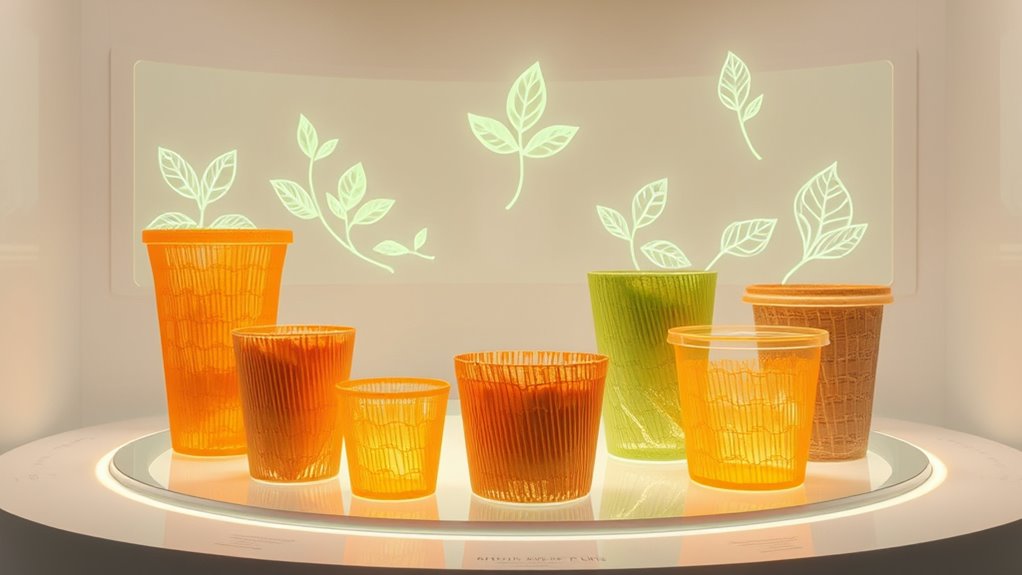In 2025, sustainable packaging is evolving beyond traditional plastics with innovative solutions. You’ll see more biodegradable materials made from plant fibers, cornstarch, or algae that break down faster and reduce landfill waste. Smart packaging technologies are gaining traction, offering real-time freshness tracking and efficient supply chain management. These advances not only cut environmental impact but also boost safety and convenience. Keep exploring to discover how these innovations are shaping a greener future for packaging.
Key Takeaways
- Development of biodegradable packaging materials from plant fibers, cornstarch, and algae to replace traditional plastics.
- Integration of smart sensors and RFID tags for real-time product tracking and freshness alerts.
- Adoption of circular economy models promoting recycling, reuse, and composting of eco-friendly packaging.
- Innovations in multi-functional packaging that combines sustainability with enhanced consumer safety and convenience.
- Increased industry investment and consumer demand driving rapid adoption of sustainable packaging solutions by 2025.

Have you ever wondered how packaging can be both eco-friendly and functional? It’s a question many consumers and companies are asking as environmental concerns grow. The answer lies in innovative solutions that reduce waste without sacrificing quality or convenience. One of the most promising developments is the use of biodegradable materials. These materials are designed to break down naturally in the environment, notably decreasing landfill accumulation and pollution. Unlike traditional plastics, which can take hundreds of years to decompose, biodegradable options offer a much quicker return to the earth’s cycle. They’re crafted from natural substances like plant fibers, cornstarch, or algae, making them more sustainable choices. When you choose products with biodegradable packaging, you’re supporting a shift towards less harmful waste management practices.
But biodegradable materials aren’t the only game-changer. Smart packaging is revolutionizing how products are stored, transported, and consumed. This technology integrates sensors, RFID tags, and other digital features directly into packaging. It allows real-time tracking of products, monitors freshness, and even provides usage instructions, all while reducing unnecessary packaging waste. For example, smart packaging can alert consumers when perishable goods are nearing expiry, minimizing food waste. It can also communicate with supply chains to optimize delivery routes, reducing emissions and energy consumption. When you see products with smart packaging, you’re witnessing a seamless blend of convenience, efficiency, and sustainability. These innovations help companies reduce excess packaging and better inform consumers, leading to more responsible consumption habits.
Both biodegradable materials and smart packaging exemplify how sustainability is transforming the packaging industry. They demonstrate a commitment to reducing environmental impact while meeting modern demands for convenience and safety. As a consumer, your choices can influence this shift—by opting for products that prioritize eco-friendly packaging, you support companies investing in these cutting-edge solutions. Manufacturers are also investing more in research, pushing the boundaries of what’s possible with sustainable materials and intelligent design. The future of packaging isn’t just about reducing plastic; it’s about rethinking how we design, produce, and dispose of packaging altogether, especially as innovations in sustainable packaging continue to evolve rapidly.
Frequently Asked Questions
What Are the Main Challenges in Adopting Sustainable Packaging Worldwide?
You face challenges like inadequate recycling infrastructure, which hampers proper waste management, and supply chain complexities that make sourcing sustainable materials difficult. These issues increase costs and slow adoption of eco-friendly packaging solutions. Additionally, you must navigate varying regulations across regions and educate consumers on sustainability. Overcoming these obstacles requires collaboration, innovation, and investment to create a more sustainable packaging landscape worldwide.
How Cost-Effective Are New Eco-Friendly Packaging Materials?
Imagine you’re in the year 2025, and eco-friendly packaging is the new black. These materials are becoming increasingly cost-effective as recycling rates improve and production scales up, making them competitive with traditional options. Their material durability guarantees they withstand shipping and handling, reducing waste and replacement costs. While initial investments might seem high, long-term savings and environmental benefits make these innovative packaging solutions a smart, sustainable choice for your business.
Are There Regulatory Hurdles for Innovative Packaging Solutions?
Yes, regulatory hurdles can impact innovative packaging solutions. You need to guarantee your designs meet regulatory compliance and certification standards, which vary by region. Managing these requirements might require extra testing and documentation, but staying informed helps you streamline approval processes. By proactively addressing these hurdles, you can bring sustainable packaging innovations to market faster and ensure they meet all safety and environmental standards.
How Do Consumer Preferences Influence Sustainable Packaging Development?
Your consumer behavior heavily influences sustainable packaging development, as brands prioritize eco-friendly options to meet demand. When customers show a preference for sustainable solutions, companies invest in innovative packaging to strengthen brand loyalty. By aligning products with eco-conscious values, you encourage brands to adopt greener materials and practices, ultimately shaping the future of packaging. Your choices directly impact industry trends and push companies toward more sustainable, innovative packaging solutions.
What Role Does Technology Play in Advancing Packaging Sustainability?
Technology drives packaging sustainability by enabling the development of biodegradable polymers that break down more easily and smart packaging that monitors product freshness. You can leverage these innovations to reduce waste and improve efficiency. By adopting biodegradable materials and integrating smart features, you contribute to environmental conservation and meet consumer demand for eco-friendly solutions. This proactive approach guarantees your packaging stays ahead in the sustainability movement.
Conclusion
As you explore these future-forward packaging ideas, you’ll find that sustainability is gently guiding us toward a more harmonious relationship with the planet. While challenges still lie ahead, embracing innovative, eco-friendly solutions helps us move softly away from old habits. Together, these subtle yet impactful changes promise a brighter, greener tomorrow—one thoughtfully designed package at a time. By choosing progress over perfection, you’re helping craft a more sustainable world for generations to come.









